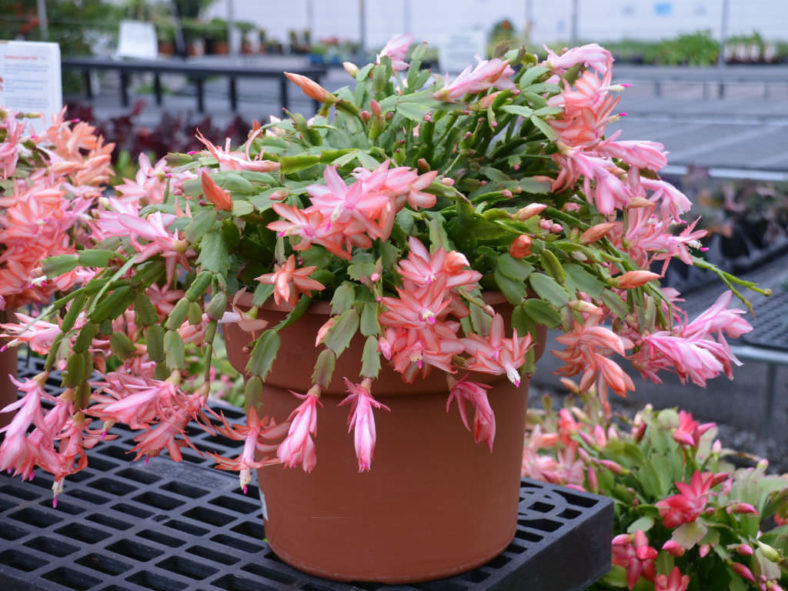A popular gift to brighten the colder months, the group of plants known as Holiday Cacti gets its name for their ability (with some help) to bloom during the holiday season. The most popular are the Christmas Cactus (Schlumbergera × buckleyi), Thanksgiving Cactus (Schlumbergera truncata), and Easter Cactus (Hatiora gaertneri), with many hybrids and color varieties available.
These easy-to-grow plants are often passed down through the generations. With a Holiday Cactus, the million-dollar question is not how to grow it but how to make it bloom. With a little extra attention during the fall months, you can have your plants blooming for the holidays.
About Holiday Cacti
The name "cactus" is a little misleading, as these plants are not related to the spiny, fleshy cacti we know and love. Instead, they are epiphytes, which means they nestle in the high branches of rainforest trees, obtaining nutrients from pockets of decaying plant matter and adapting to water shortages as rain quickly drains away.
Many orchids and bromeliads are also epiphytes. This growth habit makes these plants more adapted to the drier conditions and filtered sunlight of the tropical tree canopy, which helps them live as houseplants in temperate climates.
The blooms of Holiday Cacti come in many colors, including white, pink, red, purple, and salmon-orange. Older plants will have long, arching stems, making them well-suited for hanging baskets or plant stands.

Calendar
Do not be intimidated by the word "calendar" since these plants thrive on benign neglect. They need minimal nutrients and occasional watering and can even be stored in a cool spare room. Nevertheless, these monthly tips will help your plant thrive and bloom on demand.
- January: If you received a Holiday Cactus as a gift, you can start with the easy option. Let your plant rest for about a month after blooming. Then, keep it in a cool spot with indirect light and water it sparingly until growth starts.
- February: You can repot your Holiday Cactus if needed from now through April. They like to be root-bound, so try to resist the urge unless you feel the plant suffers from poor soil.
- March: When new growth begins, you can pinch or prune your plant. These cuttings can be rooted to make more plants!
- April–September: The plant's growing season. Every few weeks, you can feed it with an all-purpose plant food in a 1-1-1 ratio. If you move it outdoors, keep it in a cool, shady spot. Water when the top inch of soil feels dry (no more than once a week), but only water enough to moisten the root ball. Do not repeatedly soak the plant and leave water in the drainage tray.
- September – October: This is the critical period to ensure your Holiday Cactus blooms. At the beginning of September, put your Holiday Cactus in a cool room, ideally around 50 °F (10 °C), with indirect bright light for 10 to 12 hours and total darkness for 12 to 14 hours. "Total darkness" means just that: no daylight and no artificial light, either. You can easily achieve this by moving your plants in and out of a dark closet or covering them with a thick fabric. Please ensure the cover does not damage the plant. They will need these conditions for 6 to 8 weeks to ensure flower bud formation. Stop fertilizing and reduce watering to keep the soil barely moist (once every couple of weeks).
- November – December: When your plant is full of flower buds, you can stop the light-dark routine and bring your plant out to enjoy. Resume moderate watering. The cooler the location, the longer the blooms will last!
Growing Tips
- Do not expose these plants to freezing temperatures! Despite their preference for cooler temperatures, they are still tropical plants that cannot withstand freezing.
- They prefer about 50-60% humidity, which can be achieved with a pebble tray.
- Never place your Holiday Cactus near a heat register, exterior door, or drafty window, and keep it out of burning sunlight.
- Holiday cactus can be easily propagated from cuttings. First, pinch off a stem section with 2 to 3 jointed segments. Let the cuttings dry for a few hours, then plant them in a small pot using the same planting mix as the adult plant. Treat the cuttings like adult plants. They will be rooted and growing within a few weeks.
- Do not fall into the trap of constantly repotting into a bigger pot. Holiday Cactus likes to be root-bound, and repotting every 2 to 3 years (even back into the same pot) is plenty. If you repot, use sterile, well-drained potting soil, such as that packaged for African violets, orchids, or bromeliads.
Source: todayshomeowner.com
Links
- Back to genus Schlumbergera
- Succupedia: Browse succulents by Scientific Name, Common Name, Genus, Family, USDA Hardiness Zone, Origin, or cacti by Genus